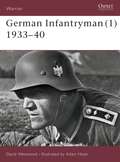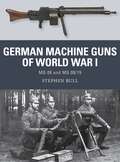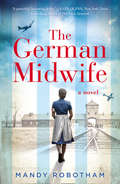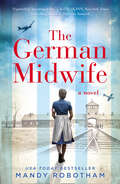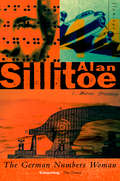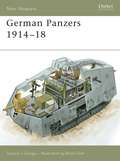- Table View
- List View
German Infantryman (Warrior #59)
by David WestwoodThe common German infantryman played a crucial role in the events that led to the outbreak of war, and the burden of duty lay on his shoulders during the opening moves of the conflict, in the invasion of Poland, the conquest of Norway and Denmark, the Low Countries and France. The Wehrmacht was unstoppable in this period, as it defeated almost every country that took the field against it. This volume examines the recruitment, training, weapons and equipment of the German infantryman in the eventful years building up to and including Blitzkrieg. Weaponry, team roles, tactics, training and personal equipment are all covered.
German Infantryman vs British Infantryman: France 1940 (Combat #14)
by David Greentree Mr Adam HookWhen Hitler's forces poured into France and the Low Countries in 1940, the uneasy peace of the 'Phoney War' was shattered, and Europe was ripped apart by another Blitzkrieg. Forming the backbone of the German advance were the well-equipped Schützen (Rifles), motorized infantry who embodied the essence of the fluid, swift warfare that had characterized World War II thus far. Facing them were infantrymen of the British Expeditionary Force, units of considerable fighting quality who had nevertheless received no special training to conduct combined-arms warfare in conjunction with armour. This study investigates the combat between the two adversaries at small-unit level, recreating the ferocity of the fighting on the front lines of the Battle of France in three key clashes at Arras, Calais and Merville. Assessing the training, organization and unit ethos of both sides in the context of a new type of mobile warfare, David Greentree reveals the extraordinary difficulties encountered by infantry units in trying to remain in contact with their armoured and mechanized formations.
German Infantryman vs British Infantryman: France 1940 (Combat)
by Adam Hook David GreentreeWhen Hitler's forces poured into France and the Low Countries in 1940, the uneasy peace of the 'Phoney War' was shattered, and Europe was ripped apart by another Blitzkrieg. Forming the backbone of the German advance were the well-equipped Schützen (Rifles), motorized infantry who embodied the essence of the fluid, swift warfare that had characterized World War II thus far. Facing them were infantrymen of the British Expeditionary Force, units of considerable fighting quality who had nevertheless received no special training to conduct combined-arms warfare in conjunction with armour. This study investigates the combat between the two adversaries at small-unit level, recreating the ferocity of the fighting on the front lines of the Battle of France in three key clashes at Arras, Calais and Merville. Assessing the training, organization and unit ethos of both sides in the context of a new type of mobile warfare, David Greentree reveals the extraordinary difficulties encountered by infantry units in trying to remain in contact with their armoured and mechanized formations.
German Infantryman vs Russian Infantryman: 1914–15 (Combat)
by Robert Forczyk Adam HookThe Eastern Front of World War I is sometimes overshadowed by the fighting in the West. But the clashes between Imperial Germany and Tsarist Russia in East Prussia, Poland and Lithuania were every bit as gruelling for the participants as the great battles in Western Europe. In spite of the crushing German victory at Tannenberg in August 1914, the war in the East would grind on into 1918, hampered by supply problems, difficult terrain and appalling weather conditions. In this study, author Robert Forczyk assesses the tactics and combat performance of both sides fighting in the brutal clashes at Gumbinnen, Göritten and Mahartse, examining their contrasting fortunes and revealing the evolving nature of infantry warfare on the Eastern Front during World War I.
German Infantryman vs Russian Infantryman: 1914–15 (Combat #11)
by Robert Forczyk Mr Adam HookThe Eastern Front of World War I is sometimes overshadowed by the fighting in the West. But the clashes between Imperial Germany and Tsarist Russia in East Prussia, Poland and Lithuania were every bit as gruelling for the participants as the great battles in Western Europe. In spite of the crushing German victory at Tannenberg in August 1914, the war in the East would grind on into 1918, hampered by supply problems, difficult terrain and appalling weather conditions. In this study, author Robert Forczyk assesses the tactics and combat performance of both sides fighting in the brutal clashes at Gumbinnen, Göritten and Mahartse, examining their contrasting fortunes and revealing the evolving nature of infantry warfare on the Eastern Front during World War I.
German Infantryman vs Soviet Rifleman: Barbarossa 1941 (Combat #7)
by David CampbellThe Axis invasion of the Soviet Union on 22 June 1941 pitted Nazi Germany and her allies against Stalin's forces in a mighty struggle for survival. Fighting alongside the spearhead Panzer divisions were Germany's highly skilled and veteran motorized infantrymen – including the German Army's premier unit, Infanterie-Regiment (mot.) Großdeutschland. Opposing these German mobile forces, the Soviets deployed the often ill-trained and poorly equipped men of the rifle regiments, who fought tenaciously and with the threat of savage reprisals from their own side. In this book three bruising clashes during the first seven weeks of the campaign are assessed – a bloody encounter battle at Zhlobin, the struggle for the destroyed city of Smolensk and then a prolonged clash along a dangerously stretched German defensive perimeter at Vas'kovo–Voroshilovo.
German Infantryman vs Soviet Rifleman: Barbarossa 1941 (Combat #7)
by Johnny Shumate David CampbellThe Axis invasion of the Soviet Union on 22 June 1941 pitted Nazi Germany and her allies against Stalin's forces in a mighty struggle for survival. Fighting alongside the spearhead Panzer divisions were Germany's highly skilled and veteran motorized infantrymen – including the German Army's premier unit, Infanterie-Regiment (mot.) Großdeutschland. Opposing these German mobile forces, the Soviets deployed the often ill-trained and poorly equipped men of the rifle regiments, who fought tenaciously and with the threat of savage reprisals from their own side. In this book three bruising clashes during the first seven weeks of the campaign are assessed – a bloody encounter battle at Zhlobin, the struggle for the destroyed city of Smolensk and then a prolonged clash along a dangerously stretched German defensive perimeter at Vas'kovo–Voroshilovo.
German-Jewish Literature in the Wake of the Holocaust: Grete Weil, Ruth Kluger and the Politics of Address (Studies in European Culture and History)
by P. BosCombining cultural history and literary analysis, this study proposes a new and thought-provoking reading of the changing relationship between Germans and Jews following the Holocaust. Two Holocaust survivors whose work became uniquely successful in the Germany of the 1980s and 1990s, Grete Weil and Ruth Kluger, emerge as exemplary in their contributions to a postwar German discussion about the Nazi legacy that had largely excluded living Jews. While acknowledging that the German audience for the works of Holocaust survivors began to change in the 1980s, this study disputes the common tendency to interpret this as a sign of greater willingness to confront the Holocaust, arguing instead that it resulted from a continued German misreading of Jews' criticisms. By tracing the particular cultural-political impact that Weil's and Kluger's works had on their German audience, it investigates the paradox of Germany's confronting the Holocaust without necessarily confronting the Jews as Germans. Furthermore, for the authors this literature also had a psychological impact: their 'return' to the German language and to Germany is read not as an act of mourning or nostalgia, but rather as a public call to Germans for a dialogue about the Nazi past, as a way to move into the public realm the private emotional and psychological battles resulting from German Jews' exclusion from and persecution by their own national community.
German Light Cruisers 1939–45 (New Vanguard)
by Ian Palmer Gordon WilliamsonThe German Navy of World War II was small in number, but contained some of the most technologically advanced capital ships in the world. This meant that although the Kriegsmarine never felt capable of encountering the might of the British Navy in a fleet action, her ships were individually more than a match for the outdated vessels of the Royal Navy. Nowhere was this more the case than in Germany's fleet of light cruisers. There were only six vessels in this fleet: the Emden, Leipzig, Köln, Königsberg, Karlsruhe and Nurnberg. This book describes their design, development and varied operational history throughout the course of the Second World War.
German Light Cruisers 1939–45 (New Vanguard)
by Gordon Williamson Mr Ian PalmerThe German Navy of World War II was small in number, but contained some of the most technologically advanced capital ships in the world. This meant that although the Kriegsmarine never felt capable of encountering the might of the British Navy in a fleet action, her ships were individually more than a match for the outdated vessels of the Royal Navy. Nowhere was this more the case than in Germany's fleet of light cruisers. There were only six vessels in this fleet: the Emden, Leipzig, Köln, Königsberg, Karlsruhe and Nurnberg. This book describes their design, development and varied operational history throughout the course of the Second World War.
German Machine Guns of World War I: MG 08 and MG 08/15 (Weapon)
by Johnny Shumate Stephen Bull Alan GillilandWorld War I's defining weapon for many, Germany's MG 08 machine gun won a formidable reputation on battlefields from Tannenberg to the Somme. Although it was a lethally effective weapon when used from static positions, the MG 08 was far too heavy to perform a mobile role on the battlefield. As the British and French began to deploy lighter machine guns alongside their heavier weapons, the Germans fielded the Danish Madsen and British Lewis as stopgaps, but chose to adapt the MG 08 into a compromise weapon – the MG 08/15 – which would play a central role in the revolutionary developments in infantry tactics that characterized the last months of the conflict. In the 1940s, the two weapons were still in service with German forces fighting in a new world war. Drawing upon eyewitness battlefield reports, this absorbing study assesses the technical performance and combat record of these redoubtable and influential German machine guns, and their strengths and limitations in a variety of battlefield roles.
German Machine Guns of World War I: MG 08 and MG 08/15 (Weapon #47)
by Johnny Shumate Alan Gilliland Dr Stephen BullWorld War I's defining weapon for many, Germany's MG 08 machine gun won a formidable reputation on battlefields from Tannenberg to the Somme. Although it was a lethally effective weapon when used from static positions, the MG 08 was far too heavy to perform a mobile role on the battlefield. As the British and French began to deploy lighter machine guns alongside their heavier weapons, the Germans fielded the Danish Madsen and British Lewis as stopgaps, but chose to adapt the MG 08 into a compromise weapon – the MG 08/15 – which would play a central role in the revolutionary developments in infantry tactics that characterized the last months of the conflict. In the 1940s, the two weapons were still in service with German forces fighting in a new world war. Drawing upon eyewitness battlefield reports, this absorbing study assesses the technical performance and combat record of these redoubtable and influential German machine guns, and their strengths and limitations in a variety of battlefield roles.
The German Midwife
by Mandy RobothamAn enthralling tale from the #1 Globe and Mail and USA Today Best Selling Author. “A powerful, haunting debut”—Kate Quinn, New York Times bestselling author of The Alice Network
The German Midwife
by Mandy RobothamThe USA Today Best Seller. An enthralling new tale of courage, betrayal and survival in the hardest of circumstances that readers of The Tattooist of Auschwitz, The Secret Orphan and My Name is Eva will love.
German Military Police Units 1939–45 (Men-at-Arms)
by Ronald Volstad Gordon WilliamsonThe military policeman must be one of the least appreciated yet most indispensable military figures in modern history. In the mobile warfare of the 20th century no army could keep its vital supply routes open without the military policeman. This book documents the organisation, uniforms and insignia of the many and varied German military police units of World War II. Their duties included traffic control; maintaining military order and discipline; collection and escorting prisoners of war; prevention of looting; disarming civilians; checking captured enemy soldiers for documents; collection of fallen enemy propaganda leaflets and providing street patrols in occupied areas.
German Military Police Units 1939–45 (Men-at-Arms #213)
by Ronald Volstad Gordon WilliamsonThe military policeman must be one of the least appreciated yet most indispensable military figures in modern history. In the mobile warfare of the 20th century no army could keep its vital supply routes open without the military policeman. This book documents the organisation, uniforms and insignia of the many and varied German military police units of World War II. Their duties included traffic control; maintaining military order and discipline; collection and escorting prisoners of war; prevention of looting; disarming civilians; checking captured enemy soldiers for documents; collection of fallen enemy propaganda leaflets and providing street patrols in occupied areas.
German Mountain & Ski Troops 1939–45 (Elite #63)
by Gordon WilliamsonFighting in every theatre from the burning sands of North Africa to the icy wastes above the arctic circle the German Army's Gebirgstruppen troops were some of the most effective in the whole of the Wehrmacht. Their esprit de corps and morale were extremely high and their commanders, men such as Eduard Dietl, the 'Hero of Narvik', and Julius 'Papa' Ringel, were idolised by their men. Dietl himself was the first soldier of the Wehrmacht to be awarded the coveted Oakleaves to the Knights Cross of the Iron Cross. In this book Gordon Williamson details the uniforms, organisation and combat histories of these elite troops.
German Mountain & Ski Troops 1939–45 (Elite)
by Gordon Williamson Stephen AndrewFighting in every theatre from the burning sands of North Africa to the icy wastes above the arctic circle the German Army's Gebirgstruppen troops were some of the most effective in the whole of the Wehrmacht. Their esprit de corps and morale were extremely high and their commanders, men such as Eduard Dietl, the 'Hero of Narvik', and Julius 'Papa' Ringel, were idolised by their men. Dietl himself was the first soldier of the Wehrmacht to be awarded the coveted Oakleaves to the Knights Cross of the Iron Cross. In this book Gordon Williamson details the uniforms, organisation and combat histories of these elite troops.
The German Numbers Woman: The Broken Chariot, The German Numbers Woman, And The Lost Flying Boat
by Alan SillitoeA top-rate novel of drugs, love and treachery from an author at the height of his powers.
The German Nurse
by M.J. HollowsA powerful and heartbreaking WWII historical novel for fans of The Tattooist of Auschwitz, The Nightingale and Beneath a Scarlet Sky. A secret past. A forbidden love. A terrifying choice.
The German Occupation of the Channel Islands
by Charles CruickshankCharles Cruickshank provides a full account of the German invasion, the subsequent landings of various British agents, raids and an attempt to end the occupation using psychological warfare. He also looks at how the islanders and Wehrmacht lived, the reality of collaboration with the occupying powers and the extent of support for the Resistance.
German-occupied Europe in the Second World War (Routledge Studies in Second World War History)
by Raffael Scheck Fabien Theofilakis Julia TorrieInspired by recent works on Nazi empire, this book provides a framework to guide occupation research with a broad comparative angle focusing on human interactions. Overcoming national compartmentalization, it examines Nazi occupations with attention to relations between occupiers and local populations and differences among occupation regimes. This is a timely book which engages in historical and current conversations on European nationalisms and the rise of right-wing populisms.
German-occupied Europe in the Second World War (Routledge Studies in Second World War History)
by Raffael Scheck Fabien Théofilakis Julia TorrieInspired by recent works on Nazi empire, this book provides a framework to guide occupation research with a broad comparative angle focusing on human interactions. Overcoming national compartmentalization, it examines Nazi occupations with attention to relations between occupiers and local populations and differences among occupation regimes. This is a timely book which engages in historical and current conversations on European nationalisms and the rise of right-wing populisms.
German Panzers 1914–18 (New Vanguard #127)
by Steven J. Zaloga Brian DelfPanzer warfare is synonymous with the Wehrmacht of World War II. This book examines the story of the Panzer's more mysterious ancestors, the little-known panzers of the Great War. Germany was very slow to develop armored vehicles compared to Britain and France. Efforts to catch-up proved difficult, and only a few dozen German A7V tanks were completed in time to take part in the final campaigns of 1918. As a result, the majority of German panzer units actually used captured British tanks, the Beutepanzer. This book will trace the development of German panzers of the World War One, including the A7V and its intended but unfinished stablemates.
